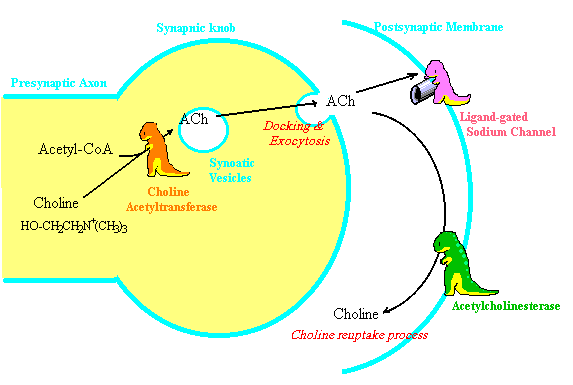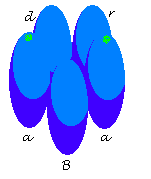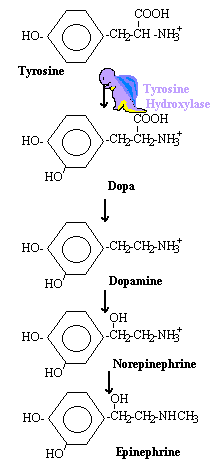NS
→Central NS
→Brain
→Spinal Cord
→Peripheral NS
→Somatic
→Autonomic
→Sympathetic
→Parasympathetic

Nervous System
(Anatomy, Physiology, Cell biology, Biochemistry, and Pharmacology)
NS |
 |
Cholinergic Synapses |
 |
1. ACh molecules aew stored in neurosecretory vesicles in the terminal
bulbs.
2. A nerve pulse from presynaptic axon opens the voltage-gated
calcium channels in the terminal bulbs.
3. Elevated cytosolic calcium levels stimulate secretion.
(a) Phosphorylation of synapsin in the membrane of neurosecretory vesicles
that the vesicles no longer binds to the cytockeleton.
(b) Rapid docking and fusion of neurosecretory vesicles with the plasma membrane
in the terminal bulbs.
4. Docking at the active zone within the presynaptic neuronal membrane.
SNARE Hypothesis to
|
||||||||||||||||||||
|
 |
Cholinergic agonistsEster: Alkaloids: 筆記:藥理 or 副作用? |
Cholinergic antagonistsAtropin/癲茄鹼: Muscarinic(/parasympathetic)
antagonist; preoperatively reducing secretions Scopolamine/hyoscine: prevent motion sickness Neuromuscular blockers: |
 |
Irreversible inhibitorsOrganophosphate/農藥: 傷腦筋(lipid solubility thus
can cross blood-brain barrier),支氣管收縮與窒息 |
Same side effects as the direct cholinergic agonists.
→ Fasciculations/過收縮麻痺
可影響Neuromuscular junction(nicotinic)
Pyridostigmine and neostigmine: Treatment of Myasthenia gravis
手術後回復用藥(tubocurarine亦可)
考古題:(題組)
5. Organophospates such as sarin are often used to improve the muscle strength
in patients with myasthenia gravis.[True or false]
6. The reversible cholinesterase inhibitors such as neostigmine are used in
the treatment of open-angle glaucoma.[True or false]
考古題:Use the examples in the following list in classifying (分類) the cholinergic agonists. (pilocarpine; bethanechol; physostigmine; parathion; muscarine) (10%)
 |
Adrenergic receptor Monoamine oxidase(MAO) and catechol-o-methyl-transferase(COMT): Blood vessels dilation, galbladder and urinaty bladder relaxation, glucose
and fatty acids released, ...... |
Adrenergic agonistsEphinephrine: Localized bleeding control Dopamine: Renal and coronary vasodilation |
Adrenergic antagonistsa-blockers:
Vasodilation and hypertention treatment β-blockers: Cardiac arrhythmias(心肌梗塞), angina(心律不整) and hypertension
management |
Stored norepinephrine releasing
Amphetamine(methylphenidate): Attention deficit hyperactivity disorder
in childern treatment.
Isoproterenol: Peripheral resistance decreasing and increase in heart
rate and cardiac output.
Norepinephrine reuptake inhibitor
Reserpin/蛇根鹼
Cocaine
筆記:作用於Uptake 1 ,為中樞神經用之回收,不經過COMT 與MAO的作用。